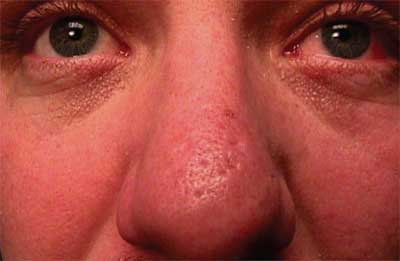
Q: I see a lot of patients who dont know they have acne rosacea. What is our role in educating and treating them?
A: Its true that people with rosacea often dont know they have it, especially in the early stages, says Joseph J. Pizzimenti, O.D., associate professor at Nova Southeastern University College of Optometry and a frequent lecturer on rosacea. Specifically, 14 million Americans have rosacea, but few of them are treated for it, the National Rosacea Society estimates. Patients attribute the facial signs to a rash or allergic reaction. As primary health-care providers, we optometrists can certainly diagnose rosacea by medical history and clinical appearance, Dr. Pizzimenti says.
 |
| The first stage of acne rosacea is characterized by persistent redness of the central axis of the face. |
Ocular rosacea, by contrast, is a distinct subtype of the systemic disease. Signs and symptoms include telangiectasia of the lid margin, conjunctivitis, blepharitis, recurrent chalazia and hordeola, foreign-body sensation, burning and stinging, Dr. Thiboutot says. Ocular signs and symptoms may occur before skin manifestations in up to 20% of patients who have ocular rosacea. Approximately half of patients experience skin lesions first, and a minority have both manifestations simultaneously.1
Many patients with the skin findings of rosacea arent aware that their eye problems are linked to the condition, Dr. Thiboutot says. Here, optometrists can play a vital role in comanaging the patient with a dermatologist to complement skin therapy with ocular therapy. Many of the oral medications that are used to treat the skin involvement can also be helpful for the eyes, she says. Likewise, the O.D. can recognize the skin manifestations in the absence of ocular findings and refer the patient to a dermatologist or family physician for further evaluation and treatment, Dr. Thiboutot says.
Possible treatments for acne rosacea may include topical and oral antimicrobial therapy, topical and oral retinoid therapy, topical vitamin C therapy, pulse-dye laser therapy and, in extreme cases, cosmetic surgery, Dr. Pizzimenti says. We should also counsel our patients to avoid certain triggers, such as sunlight, spicy foods, hot beverages, alcohol and stress.
In April, the FDA approved Oracea (doxycycline, CollaGenex Pharmaceuticals) to treat inflammatory rosacea (papules and pustules) in adult patients. Although doxycycline is currently used as an antibiotic, this formulation is different: Oracea contains 30mg of immediate-release medication and 10mg delayed-release medication.
The benefit of this medication is that it doesnt act as an antibiotic, so you dont have to worry about the development of antibiotic resistance and bacteria, Dr. Thiboutot says. Oracea hasnt yet been studied specifically for ocular rosacea, but theoretically it seems likely to be helpful in reducing inflammation, she says.
There is no diagnostic test for ocular rosacea yet, but there is one in development. Researchers at the University of California Davis have discovered that the presence of high levels of oligosaccharides in tears may be a diagnostic indicator for ocular rosacea. But further investigation is necessary to identify the exact compounds that will identify the condition.
1. Browning DJ, Proia AD. Ocular rosacea. Surv Ophthalmol 1986 Nov-Dec;31(3):145-58.

